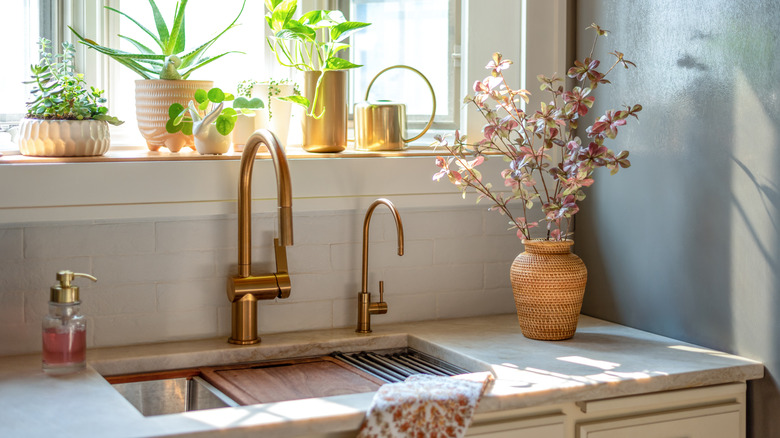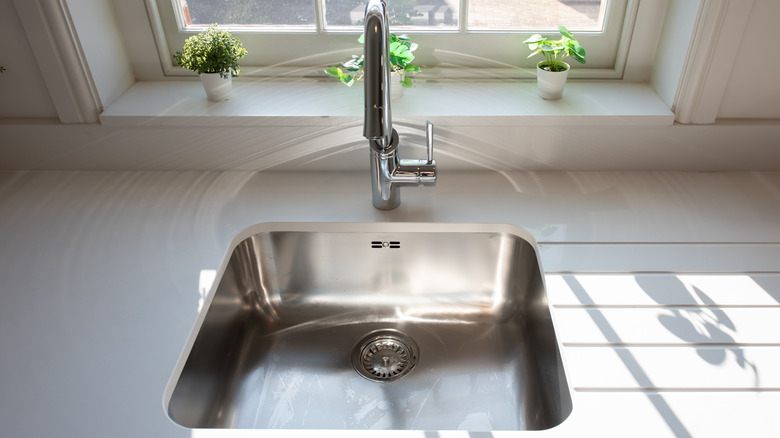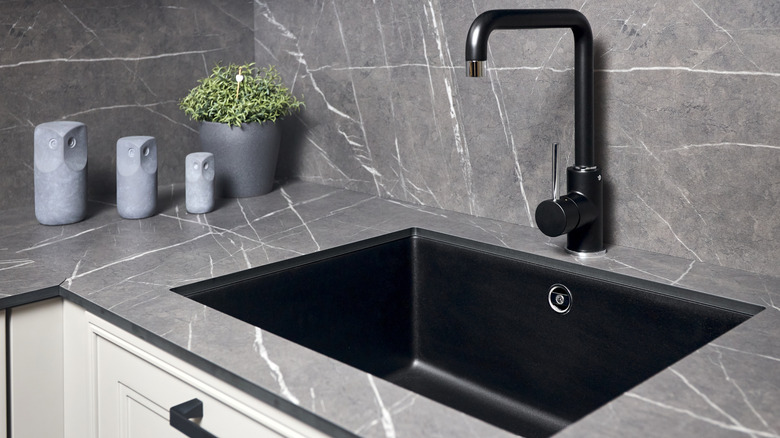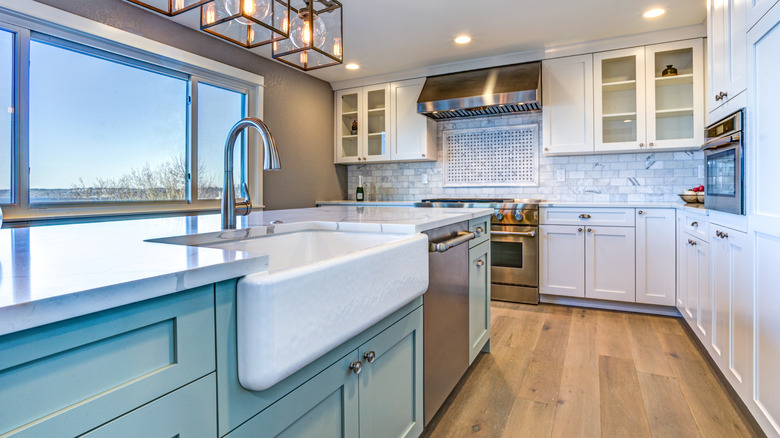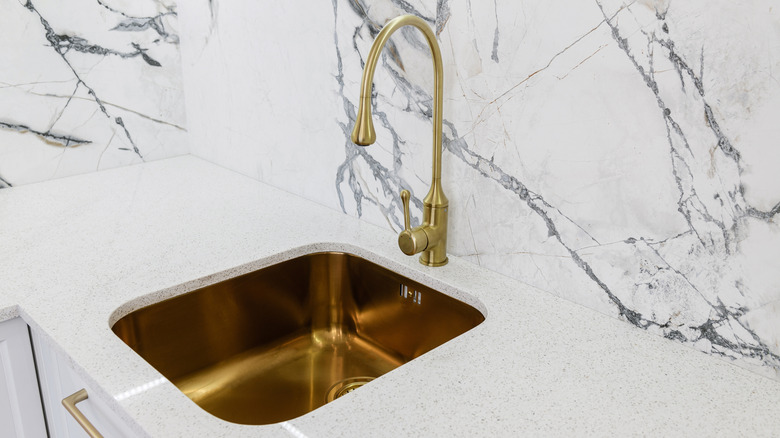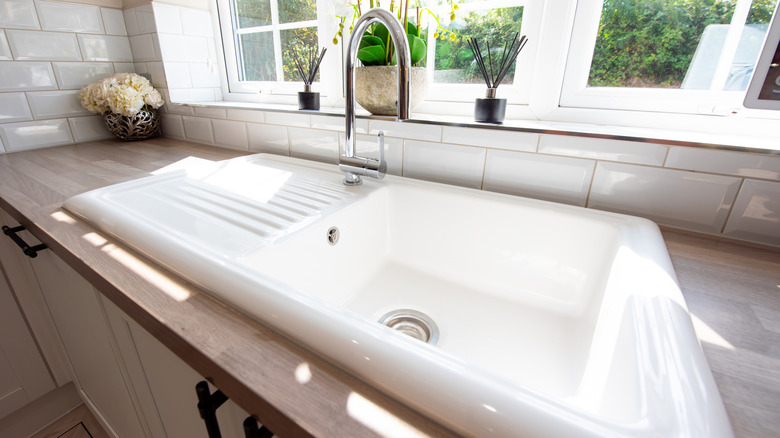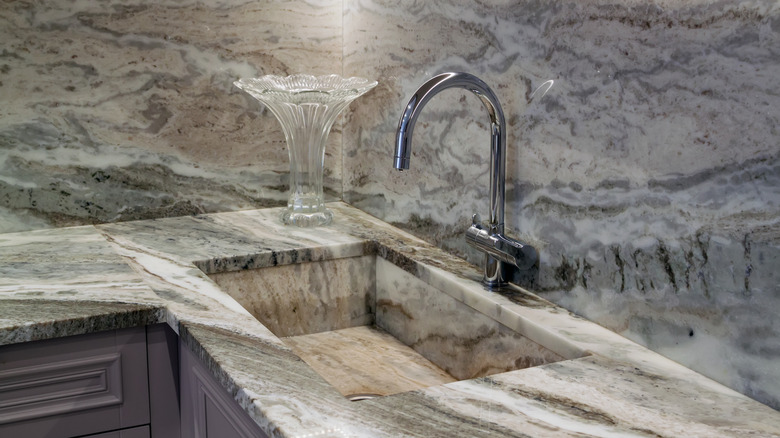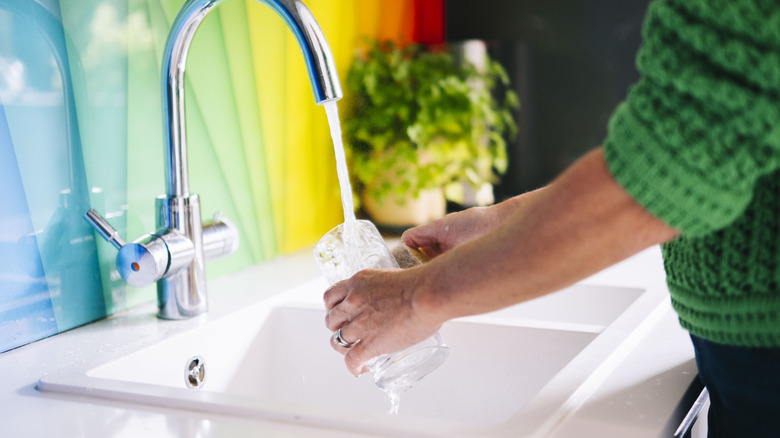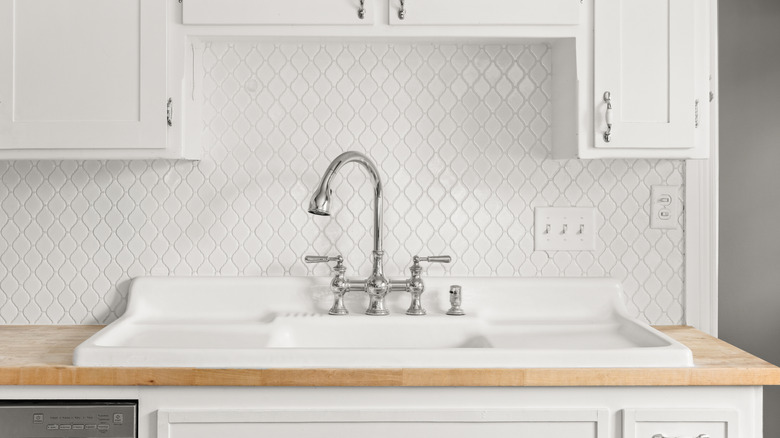The Pros And Cons Of 8 Materials For Your New Kitchen Sink
For avid home cooks, it's likely that you spend a lot of time standing at your kitchen sink. Cooking is the fun part –- the downside is that it creates plenty of dishes, even if you clean as you go. If you are blessed enough to have a dishwasher, it's unlikely that you are able to avoid the line up of dirty dishes after a meal since there are still plenty of wooden utensils, pans, and knives that still need to be hand washed.
That said, your kitchen sink is an often overlooked workhorse in the kitchen. Over time, it can start to show some wear and tear in the form of dents, scratches, stains, and more. If your kitchen sink is in need of an upgrade after years of doing dish duty, you'll want to shop for the right sink for your needs.
To help you make the best decision for your kitchen, we asked the experts for their thoughts on the pros and cons of common kitchen sink materials since you'll often be weighing function versus aesthetics. "Being fully aware of the sink properties (and desired look) that you are contemplating and being fully aware of your personal priorities of aesthetics vs. function will reveal what the right material is for your kitchen design," says Susan Serra, president and designer at Susan Serra Associates, Inc. Read on to find out what they said about everything from stainless steel to fireclay and copper sinks.
Stainless steel
"With over four decades of experience in kitchen design and sink manufacturing, I've seen countless materials come and go — but stainless steel has remained the gold standard for a reason" says Dino Rachiele, owner of Rachiele Custom Sinks. He explains that stainless steel remains popular because it is easy to maintain and highly durable.
Looeeze Grossman, founder of The Used Kitchen Company, also agrees that stainless steel is a solid choice for those shopping for a new kitchen sink in large part due to their durability. "These sinks are highly resistant to staining, scratching, and heat. Its ability to maintain its shine and style with minimal effort offers homeowners a sink that remains pristine and functional even with everyday use," she says. What's more, the reasonable cost of stainless steel is also a selling point as well as the wide vanity of sizes, shapes, and configurations available.
Stainless steel isn't without flaws however. According to Serra, "The finish can get cloudy if not cleaned regularly ... watermarks always occur, another disappointing visual characteristic." In addition, while stainless steel is resistant to scratches it isn't entirely scratch-proof. The good news is that scratches can be buffed out with the help of a professional, per Serra.
Stone composite
Another sink material to consider is a composite sink. "Composite sinks often contain granite or quartz combined with a binder that creates a highly durable product that will last for the lifespan of the kitchen," says Susan Serra. In contrast to stainless steel sinks, these ones come in a range of colors, finishes, and styles, so you can find the one that best complements your countertops and overall kitchen design. "Composite sinks cover all the bases. For those homeowners who want a minimalist look to their kitchen, or for those who want to create an interesting focal point," according to Serra.
Although the durability of stone composite sinks is a pro, it is also very hard and less forgiving than stainless steel. That means that, if you're not careful, you might break delicate glassware or other dishes on the solid surface. Dino Rachiele adds that while composite sinks (especially granite composite sinks) have gained traction, cracking and staining are still potential issues. When it comes to cost, good quality stone composite sinks are more expensive than porcelain or stainless steel. Finally, these sinks are often heavier than other options, so that's a factor to consider before install in case you need to provide additional structural support.
Fireclay
If you're after that farmhouse feel, you have likely looked at the different options for farmhouse style sinks (also called apron sinks). While some are made from porcelain, many of this style of sink are made from fireclay. This is a clay-based ceramic that has been heated at a high temperature to fuse the glaze and clay together. Courtney Cole, interior designer for TileCloud, finds that although not as many people are familiar with fireclay, it can be an elegant choice.
"It's heavy duty, resists chips and scratches, and has this really clean timeless look," says Michael Hartel, founder of CabinetIQ. Despite looking high-end, the other great thing about fireclay is that it is still affordable compared to other sink materials, like cast iron. Some of the cons to buying a fireclay sink is that over time it can pick up stains, but keeping up with day-to-day cleaning helps keep them at bay. In addition, part of the appeal of fireclay sinks is the handcrafted look, but these slight variations in the shape can create areas where water pools which can lead to water stains. That being said, it's important to wipe out water after use.
Copper
While it's going to be a bigger investment, copper sinks add charm and character to a kitchen. Dino Rachiele adds that they are not only visually striking, but copper sinks (as well as brass and bronze) age gracefully. "[They] offer a level of performance synthetic materials simply can't replicate," he says. With use, copper sinks develop a unique patina over time. "No two are ever the same and for some homeowners that individuality is a big selling point" says Michael Hartel.
Of course, choosing a copper sink comes with some trade-offs. In general, copper sinks need a bit more day-to-day maintenance than other sink materials. To protect the patina on your copper sink, you'll need to be more vigilant about leaving acidic food scraps like citrus or tomatoes in your sink. Some cleaners like bleach or chemicals used for unclogging the drain may also damage the patina, so make sure you're cleaning with the right products. Excess exposure to moisture can cause green spots so drying the sink with a cloth after use is an important day-to-day task.
Enameled cast iron
Enameled cast iron is a popular material for cookware like dutch ovens, but it is also commonly used for kitchen sinks as well. Like fireclay, enameled cast iron has a smooth finish that is easy to clean and stain resistant. These sinks also have more color options than fireclay, so you can customize to suit your kitchen design. Like the cookware, enameled cast iron sinks are heavy, so that's an important factor to keep in mind for installation — some sink sizes can weigh as much as 125 pounds.
There's also a bigger price tag on enameled cast iron sinks, but they look great in period-style Victorian or farmhouse kitchens. If you're considering this option, Dino Rachiele encourages you to be cautious. He says they look great, but they are prone to chips. "These sinks can chip on day one or hold up for years — there's simply no predicting it. The average lifespan ranges anywhere from five to 20 years, and repairs are rarely possible," he said.
The best way to prevent chips and scratches is to avoid dropping heavy cookware into the sink -– installing a rubber mat or rack in the sink can help. If you're deciding between fireclay and enameled cast iron for your sink, one advantage of fireclay is that chips are less noticeable. This is because the color runs through the entire sink, whereas you'll see the dark cast iron underneath the enamel where it's chipped (especially with light-colored enamel). Those chips are also prone to rust in cast iron sinks.
Natural stone
Natural stone is a solid choice for a beautiful kitchen sink that will stand the test of time. These sinks are typically made from either marble, granite, soapstone, quartz or limestone. A design perk of this sink material is that you can have one custom fitted with the same type of stone as your countertops for a high-end seamless look. Of course, natural stone comes with a much higher price tag than say, stainless steel. In addition, these sinks are much heavier, so there is a higher upfront cost for installation and reinforcement.
Beyond the aesthetics, stone sinks are very durable, and you likely won't have to worry about chips like other sink materials. However, you do need to be a little cautious about putting dishware into these sinks. "Super hard sinks such as soapstone, quartz sinks made of countertop materials, marble and granite, while beautiful, are so dense that glass objects should be carefully placed into and around the sink to prevent breakage," says Susan Serra. Kitchen sinks made from stone also need more maintenance than other materials. Since the surface is porous, they need to be resealed every year or two to prevent cracks, chips and stains. Serra also says to be careful of leaving certain acidic foods in the sink too long, as they can cause discoloration. The same goes for avoiding household cleaners or abrasive materials when cleaning your sink.
Solid surface
Like stainless steel, solid surface sinks (also known as acrylic resin) are an affordable kitchen sink material option for those who might be updating their kitchen on a tight budget. However, the cost savings up front might not be worth it in the long run. Courtney Cole warns, "Saving money and going for something like plastic or a cheap acrylic sink can seem like a good choice to begin with, but over time they are pretty prone to scratching, and will wear quickly."
In addition to the greater potential for scratches and stains, solid surface sinks are also sensitive to high temperatures, so be wary of placing hot pots and pans in these sinks. While you weigh the cons, there are some benefits to solid surface sinks. These sinks are lightweight, so they're easier to install on your own and don't need the reinforcement that other sink materials like enameled cast iron or natural stone. They are also a great material for kitchens, since they are antimicrobial and anti-bacterial.
Porcelain
Porcelain has long been a popular option for kitchen sinks since it is easy to clean and maintain. This sink material is made from firing potter clay and kaolin at very high temperatures (although not as high as fireclay); in some cases, it is molded around a metal core of steel or iron. Porcelain may be a good fit for your kitchen if you are looking for a clean, timeless finish that has moderate stain, heat, and scratch-resistance at an affordable price.
However, if you cook a lot or have heavy pots and pans (like cast iron), porcelain may not be the best material for a high-use and busy kitchen. According to Looeeze Grossman, it can be more prone to chipping and cracking than other options. In terms of durability, a fireclay sink may be the better choice, as they are more scratch-, stain-, and chip-resistant than porcelain. While porcelain may be susceptible to staining, if you keep up with regular cleaning (just a quick scrub with baking soda and hydrogen peroxide is all you need), you can stay ahead of them.
